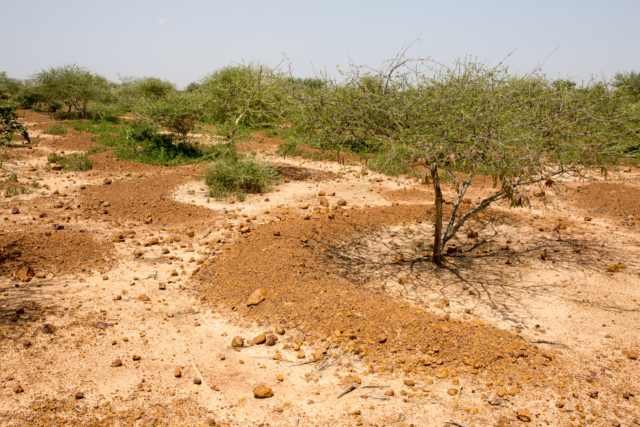Environmental Solutions to Poverty
 Changing ecosystems from economic development have increased the risk of poverty and food insecurity around the world. Informal sectors, which mostly exist in lower-income countries, sidestep environmental regulations. This further degrades the environment and puts more people at risk of poverty. However, these high-risk environments also provide an opportunity to implement environmental solutions to poverty and lower the risk of environmental destruction.
Changing ecosystems from economic development have increased the risk of poverty and food insecurity around the world. Informal sectors, which mostly exist in lower-income countries, sidestep environmental regulations. This further degrades the environment and puts more people at risk of poverty. However, these high-risk environments also provide an opportunity to implement environmental solutions to poverty and lower the risk of environmental destruction.
Demi-Lune Agriculture to Stop Desertification
In the past century, deserts have expanded rapidly due to industrialization and rising global populations. This threatens millions of people living on the periphery of deserts who farm for a living, people who may see their crops dry up in coming years. Environmental solutions to poverty often focus on stopping the expansion of deserts.
For example, farmers on the periphery of the Sahara Desert have adopted a new style of farming to adapt to the desertification of their farmland: half-moon agriculture. This environmental solution to poverty, introduced in the 1980s, has many benefits.
Half-moons retain water much more efficiently than traditional agricultural techniques, an important feature in water-scarce climates. Farmers can easily understand and execute the process, which only requires basic tools, increasing its usability in communities with poor education and literacy.
In West Africa, half-moon agriculture has led to an incredible transformation of the landscape, with formerly arid land now covered in grass, trees or crops. Binta Cheffou, a farmer in Niger, planted half-moons in the 1990s when her community’s land was bare and unproductive.
Now, according to Cheffou, “Many people are no longer hungry” due to increased livestock yields and more agriculture. Communities using this environmental solution to poverty have witnessed a large increase in biodiversity as well, a useful safeguard against ecological disasters.
Planting Trees to Reduce Landslides
Natural disasters pose a large barrier in the fight against poverty, causing $210 billion in damage in 2020, according to major insurers. Landslides, a common disaster in developing countries, kill nearly 4,500 people each year, according to earth scientist Dave Petley. There are several environmental solutions to poverty and natural disasters, including a simple one: planting trees.
Landslides largely occur in environments where erosion is widespread and the ground can no longer hold its weight. These conditions often emerge just after deforestation and unregulated mining, where people extracting resources leave hillsides barren and organic structures rotten.
The lack of organic structure holding the slopes together leads to these tragic natural disasters. Reverting the hillside to its natural state with biodiverse trees can provide the structure necessary to prevent landslides while also providing revenue to those caring for the trees.
This strategy, popularized worldwide in the past few years, has seen major success in preventing landslides and reducing poverty. In Ethiopia, studies in communities with tree-planting initiatives noted a dramatic increase in community income and food supply. In Indonesia, research confirmed a decrease in landslides where trees were present. The study found that coffee trees prevent landslides especially well with the added benefit of providing coffee beans for communities to harvest and sell. This would decrease the motivation for unregulated logging and mining, further reducing landslide risk.
Cleaning Rivers for Clean Water
Rivers serve as key assets for countries to fuel their development. Rivers can provide power, food, drinking water and trade routes. Furthermore, recreational activities on rivers provide economic stimulation. However, many of the world’s key rivers, especially in developing countries, are experiencing a crisis of pollution and wastewater. This pollution costs countries billions of dollars. As such, key environmental solutions to poverty should focus on cleaning rivers and ensuring proper wastewater systems to prevent pollution.
In Indonesia, where riverway pollution costs $6.3 billion each year, or 2.3% of GDP, the government aims to make river water drinkable by 2025. Indonesia is implementing several strategies to address river pollution and protect the environment, including tree planting to combat erosion and regulations to ensure water factories produce drinkable water from rivers. Indonesia also focuses on environmental education as many people discard domestic trash in rivers without considering the consequences.
India also suffers from polluted rivers. The Ganga River, sacred to Hindus, serves almost 400 million people, providing water for drinking, irrigation and industry. It also deposits significant amounts of plastic into the Bay of Bengal and is filled with damaging pollutants which cause waterborne diseases that kill 1.5 million children per year.
The Indian government is focusing on the tributaries to the Ganga, ensuring clean water flows into the major river for a long-term cleaning strategy. So far, the government has spent $3 billion on cleanup initiatives since 2015 and has doubled sewage capacity.
The Future
These environmental solutions to poverty can increase both wealth and living standards. Studies show that access to a green and clean environment can boost mental health and life expectancy. Clean rivers, green hillsides and re-purposed desert land can provide access to these benefits worldwide. Going forward, governments should focus on innovative solutions to both improve the environment and reduce poverty.
– Justin Morgan
Photo: Flickr
